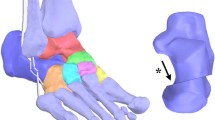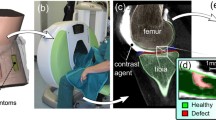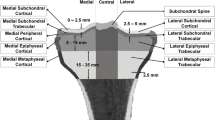Abstract
A contact finite element (FE) formulation is introduced, amenable to patient-specific analysis of cumulative cartilage mechano-stimulus attributable to habitual functional activity. CT scans of individual human ankles are segmented to delineate bony margins. Each bone surface is projected outward to create a second surface, and the intervening volume is then meshed with continuum hexahedral elements. The tibia is positioned relative to the talus into a weight-bearing apposition. The articular members are first engaged under light preload, then plantar-/dorsi-flexion kinematics and resultant loadings are input for serial FE solutions at 13 instants of the stance phase of level walking gait. Cartilage stress histories are post-processed to recover distributions of cumulative stress-time mechano-stimulus, a metric of degeneration propensity. Consistency in computed contact stress exposures presented for seven intact ankles stood in contrast to the higher magnitude and more focal exposures in an incongruously reduced tibial plafond fracture. This analytical procedure provides patient-specific estimates of degeneration propensity due to various mechanical abnormalities, and it provides a platform from which the mechanical efficacy of alternative surgical interventions can be estimated.
Similar content being viewed by others
References
Adams DJ, Spirt AA, Brown TD, Fritton SP, Rubin CT, Brand RA (1997) Testing the daily stress stimulus theory of bone adaptation with natural and experimentally controlled strain histories. J Biomech 30:671–678
Bottlang M, Marsh JL, Brown TD (1999) Articulated external fixation of the ankle: minimizing motion resistance by accurate axis alignment. J Biomech 32:63–70
Brown TD, Rudert MJ, Grosland NM (2004) New methods for assessing cartilage contact stress after articular Fracture. Clin Orthop Relat Res 423:52–58
Brown TD, Hurlbut PT, Hale JE, Gibbons TA, Caldwell NJ, Marsh JL, Nepola JV (1994) Effects of imposed hindfoot constraint on ankle contact mechanics for displaced lateral malleolar fractures. J Orthop Trauma 8:511–519
Buckwalter JA, Brown TD (2004) Joint injury, repair, and remodeling – roles in post-traumatic osteoarthritis. Clin Orthop Relat Res 423:7–16
Canny J (1986) A computational approach for edge detection. IEEE Trans Pattern Anal Mach Intell 8:679–698
Carter DR, Fyhrie DP, Whalen RT (1987) Trabecular bone density and loading history: regulation of tissue biology by mechanical energy. J Biomech 20:785–795
Cole AA, Kuettner KE (2002) Molecular basis for difference between human joints. Cell Mol Life Sci 59:19–26
Felson DT, Lawrence RC, Dieppe PA, Hirsch R, Helmick CG, Jordan JM, Kington RS, Lane NE, Nevitt MC, Zhang Y, Sowers M, McAlindon T, Spector TD, Poole AR, Yanovski SZ, Ateshian G, Sharma L, Buckwalter JA, Brandt KD, Fries JF (2000) Osteoarthritis: new insights. Part 1: the disease and its risk factors. NIH scientific conference 23–24 July 1999. Ann Intern Med 133:635–646
Flatow EL, Ateshian GA, Soslowsky LJ, Pawluk RJ, Grelsamer RP, Mow VC, Bigliani LU (1994) Computer simulation of glenohumeral and patellofemoral subluxation. Estimating pathological articular contact. Clin Orthop Relat Res 306:28–33
Genda E, Iwasaki N, Li G, MacWilliams BA, Barrance PJ, Chao EY (2001) Normal hip joint contact pressure distribution in single-leg standing-effect of gender and anatomic parameters. J Biomech 34:895–905
Grosland NM, Brown TD (2002) A voxel-based formulation for contact finite element analysis. Comp Methods Biomech Biomed Eng 5:21–32
Hadley NA, Brown TD, Weinstein SL (1990) The effects of contact pressure elevations and aseptic necrosis on the long-term outcome of congenital hip dislocation. J Orthop Res 8:504–513
Han S-K, Federico S, Epstein M, Herzog W (2005) An articular cartilage contact model based on real surface geometry. J Biomech 38:179–184
Keyak JH, Meagher JM, Skinner HB, Mote CD Jr (1990) Automated three-dimensional finite element modelling of bone: a new method. J Biomed Eng 12:389–397
Linn FC (1967) Lubrication of animal joints. J Bone Joint Surg [Am]49:1079–1098
Mavcic B, Slivnik T, Antolic V, Iglic A, Kralj-Iglic V (2004) High contact hip stress is related to the development of hip pathology with increasing age. Clin Biomech 19:939–943
Maxian TA, Brown TD, Weinstein SL (1995) Chronic stress tolerance levels for human articular cartilage: two nonuniform contact models applied to long-term follow-up of CDH. J Biomech 28:159–166
McKinley TO, Rudert MJ, Koos DC, Pedersen DR, Baer TE, Tochigi Y, Brown TD (2005) Contact stress transients during functional loading of ankle stepoff incongruities. J Biomech (in press)
Mow VC, Ateshian GA, Spilker RL (1993) Biomechanics of diarthrodial joints: a review of twenty years of progress. J Biomech Eng 115:460–467
Schmalzried TP, Shepherd EF, Dorey FJ, Jackson WO, dela Rosa M, Fa’vae F, McKellop HA, McClung CD, Martell J, Moreland JR, Amstutz HC (2000) The John Charnley Award. Wear is a function of use, not time. Clin Orthop Relat Res. 381:36–46
Stauffer RN, Chao EY, Brewster RC (1977) Force and motion analysis of the normal, diseased, and prosthetic ankle joint. Clin Orthop Relat Res 127:189–196
Steffensmeier SJ, Saltzman CL, Berbaum KS, Brown TD (1996) Effects of medial and lateral displacement calcaneal osteotomies on tibiotalar joint contact stresses. J Orthop Res 14:980–985
Thomas RH, Daniels TR (2003) Ankle Arthritis (Current Concepts Review). J Bone Joint Surg 85A:923–936
Tochigi Y, Rudert MJ, Amendola A, Brown TD, Saltzman CL (2005) Tensile engagement of the peri-ankle ligaments in stance phase. Foot Ankle Int’l 26:1067–1073
Tochigi Y, Suh J-S, Amendola A, Saltzman CL (2006) Ankle alignment on lateral radiographs: part 2: reliability and validity of measures. Foot Ankle Int’l 27:88–92
Van Rietbergen B, Huiskes R, Eckstein F, Ruegsegger P (2003) Trabecular bone tissue strains in the healthy and osteoporotic human femur. J Bone Mineral Res 18:1781–1788
Vrahas M, Fu F, Veenis B (1994) Intraarticular contact stresses with simulated ankle malunions. J Orthop Trauma 8:159–166
Author information
Authors and Affiliations
Corresponding author
Rights and permissions
About this article
Cite this article
Anderson, D.D., Goldsworthy, J.K., Shivanna, K. et al. Intra-articular Contact Stress Distributions at the Ankle Throughout Stance Phase–patient-specific Finite Element Analysis as a Metric of Degeneration Propensity. Biomech Model Mechanobiol 5, 82–89 (2006). https://doi.org/10.1007/s10237-006-0025-2
Received:
Accepted:
Published:
Issue Date:
DOI: https://doi.org/10.1007/s10237-006-0025-2




